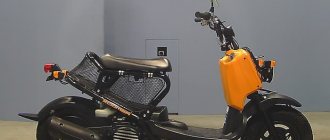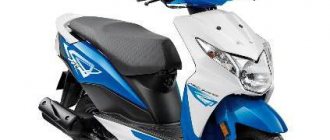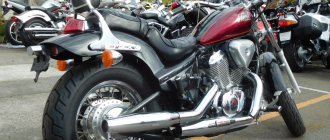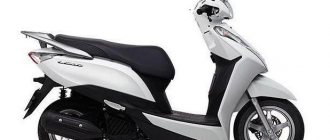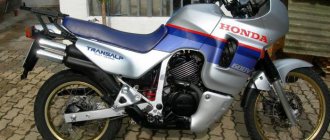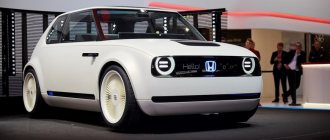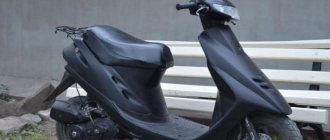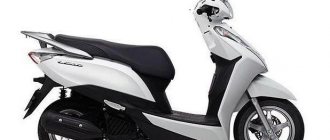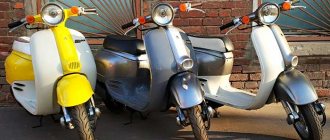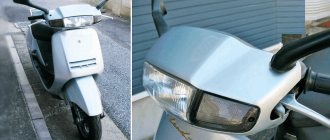The Japanese scooter Honda Gyro X is a fairly fast, but extremely safe tricycle that is suitable for both experienced riders and beginners. Thanks to the automatic transmission and three wheels, almost any adult and even a teenager can drive it. Japanese scooters are very reliable, therefore, with proper careful handling, they do not require special maintenance. It is enough to follow the simplest instructions, and the scooter will serve you for many years.
All Japanese scooters of the “Gyro” series, by the way, produced since 1982, have a skewing mechanism, which consists of two parts: front and rear. The scooter body (the main front part), through a movable articulated base, rests on a rear bogie, consisting of a 50 cm³ gasoline engine and two rear wheels. When maneuvering, the rear trolley does not change its position relative to the road surface, and the main part of the scooter tilts towards the turn.
The three-wheeled scooter Honda Giro X is, first of all, high Japanese quality and practicality, comfort and functionality. Cost-effectiveness, stylish exterior, comfortable driving position and ease of operation, excellent stability while driving, the presence of a small front and spacious rear trunk, as well as many other advantages, make this compact scooter an equally effective vehicle in urban environments and in rural areas.
Companies that require prompt courier delivery are often keen to buy a new Honda Gyro X scooter. These companies include small cargo delivery companies: online stores, pizzerias, restaurants, cafes, sushi bars, etc. For an ordinary citizen, the price of a three-wheeled scooter without mileage is decent, but for a commercial organization it is quite acceptable. However, private buyers should not despair, because you can always buy such a used scooter.
Our online store sells new Honda Giro X scooters on order. After making an advance payment, the buyer will need 30-40 days of waiting. This is exactly how much we will need to deliver the scooter from Japan. For those who don’t want to wait, we can offer used tricycles of this model at a lower price, with our proprietary pre-sale preparation, during which all consumable parts are replaced with original new ones, including oils and operating fluids.
The single-seater Honda Gyro X 50 scooter will not disappoint its owner. The low-pressure rear wheels allow the scooter to be used on country dirt roads, not excluding the winter period. Having a scooter on three wheels in a village, in a country house or for a resident of a small village is very convenient and practical. The speed of 60 km/h, by the way, is limited to this value to increase safety, and two trunks allow you to quickly move short distances and transport light loads.
The multifunctional three-wheeled scooter Gyrop Canopy is presented by the Japanese manufacturer in two modifications with a roof - TA-01 with a two-stroke engine and a later version TA-03, equipped with a four-stroke liquid-cooled injection power unit. Both versions of scooters are classified as “fifty dollars” class, since the working volumes of their single-cylinder engines with a power of 5 hp, achieved at 6500 rpm, are equal to 49 cm³.
With a minimum cubic capacity, scooters with a total weight of 120 kg (without driver and cargo) are very playful and can accelerate to 60 km/h. However, this is not the maximum speed indicator of the Gyrop Canopy, since it is forcibly limited by electronics. Sufficient ground clearance of 17 cm and the maximum permissible load on the suspension provide the Japanese tricycle with confident movement not only in urban conditions, but also in rural areas.
Auto scooter Gyro Canopy
, as a scooter with a roof is also called, is equipped with a spacious trunk, traditionally attached to the rear. Reliable drum brakes ensure driving safety. A roof over your head, a soft seat, a windshield with a car-type windshield wiper, rear-view mirrors, electric start, two headlights, turn signals - all this creates comfort while driving Japanese Honda scooters.
The Gyro Canopy scooter is perfect for transporting small loads or for delivering goods, for example, from an online store. The Honda three-wheeled scooter is a multi-purpose scooter. It has gained popularity due to its practicality, reliability, efficiency and durability, as well as the ability to operate it practically all year round. Therefore, these scooters are often purchased specifically for corporate purposes.
The reliability of Japanese scooters is legendary. A large number of buyers are consciously or subconsciously aimed at Japanese motorcycle equipment. But most of them were always upset and stopped from purchasing by one fact - the high price. A similar tricycle costs about $9,000, which is not very cheap. Therefore, enterprising businessmen import inexpensive used scooters from Japan and put them up for sale as used products.
Having carried out pre-sale preparation, which includes replacing the battery, tires, brake pads, air and fuel filters, spark plugs, variator belt and much more, including changing all operating fluids, that is, in fact, the seller is making a major overhaul of the scooter. After such “prevention”, for example, a ten-year-old used scooter is offered to be purchased for approximately $3,000 - three times cheaper than a new one.
Japanese Honda scooters
very ascetic in design and in their structure. European manufacturers are aimed at maximum manufacturability of similar equipment, and complex innovations, as is known, do not guarantee the reliability of proven technologies and significantly increase the cost of a scooter. A proven and time-tested rule: “The simpler, the more reliable!” votes for Honda Gyro Canopy. And repairs won’t be that expensive, but sooner or later everything has to be repaired, even Japanese scooters.
Review
Honda Canopy has a nondescript appearance. Behind the driver's seat there is a high-capacity trunk. The trunk is equipped with a convenient locking mechanism and a moisture protection function. You can easily fit medium bags inside.
The Canopy Combo scooter consumes only 2.5 liters of fuel per 100 kilometers. This makes it possible to use the scooter throughout the year without fear of running out of fuel or lack of other resources.
Like other scooters from the Japanese manufacturer, this model also underwent tuning and modernization. Depending on the year of manufacture, they were equipped with TA-03, TA02 engines and their modifications. This entails a difference in some technical characteristics from the basic ones.
Specifications
| Length | 1895 mm |
| Width | 660 mm |
| Full Height | 1690 mm |
| Seat height | 769 mm |
| Base | 1410 mm |
| Clearance | 170 mm |
| Speed max | 60 km/h |
| Oil tank | 1.2 liters |
| Gasoline tank | 7.3 liters |
| Weight | 120 kg |
| engine's type | TA03E |
| Fuel system | Injection |
| Cooling | Liquid |
| Working volume | 49 cm3 |
| Number of cylinders | 1 |
| Number of cycles | 4t |
| Cylinder diameter | 40 mm |
| Piston stroke | 39.3 mm |
| Power | 5.0 hp at 6500 rpm min. |
| Torque | 5.7hp at 6500 rpm min. |
| Start | Kick and electric starter |
| Drive unit | V-belt variator |
| Number of gears | 4 |
| Compression | 5,2 |
| Manufacturing city | Tokyo |
Related cars
Honda Stream
Honda Stream
| Manufacturer | Honda Motor Company |
| Also called | NV50, TB07 |
| Production | 1981–1983 |
| Engine | 49 cc 2-stroke air-cooled |
| Power | 3.8 hp at 6500 rpm |
| Torque | 0.46 kg-m at 5500 rpm |
| Transmission of infection | Continuously variable transmission |
| Tires | 8-3.00-2PR |
| Wheelbase | 1.210 m |
| Dimensions | L: 1.665 m W: 0.570 m H: 0.970 m |
| Seat height | 0.658 m |
| Weight | 74 kg (dry) 79 kg (wet) |
| Fuel tank capacity | 4 l |
| Fuel consumption | 74 km/l @ 30 km/h |
| Turning radius | 1.7 m |
Stream was introduced in November 1981. This is Honda's first tilting three-wheeler and has the basic characteristics of this type. It is a single-seater, scooter-like vehicle with an automatic transmission and a one-push parking brake. It has a small hinged rear end containing a 49cc 2-stroke engine. See and two drive wheels driven through a limited slip differential.
The Stream has been designed and priced as a luxury personal scooter. Honda's suggested retail price in 1981 was 198,000 yen, compared to 114,000 yen for the 49cc. Super cub. Unlike the Cub, the Stream can only carry one rider and does not have a trunk. The only cargo capacity is a small 5kg nose compartment and a 2kg glovebox. Production ceased in 1984.[27][28][29]
Honda Joy
Honda Joy
| Manufacturer | Honda Motor Company |
| Also called | NM50 |
| Production | 1983–1984 |
| Engine | TB08E 49 cc, air-cooled, 2-stroke |
| Power | 3.7 hp @ 6000 rpm |
| Torque | 0.47 kg-m at 5000 rpm |
| Weight | 46 kg (dry) |
Joy was introduced in April 1983. It was a significantly less expensive car than the Stream, priced at just 99,800 yen. This is a personal vehicle that only has a small bicycle-style front basket and an equally small rear rack. The truck-oriented Gyro X of the same year was twice as heavy and cost ¥189,000. Joy was discontinued in 1984.[30][31]
Honda Just
Honda Just
| Manufacturer | Honda Motor Company |
| Also called | NN50, A-TB09 |
| Production | 1983 |
| Engine | TB08E 49 cc, air-cooled, 2-stroke |
| Power | 3.7 hp @ 6000 rpm |
| Torque | 0.47 kg-m at 5000 rpm |
| Transmission of infection | 2-speed automatic transmission |
| Tires | 2.75-10-2PR / 3.00-8-2PR |
| Dimensions | L: 1.520 m W: 0.620 m H: 0.945 m |
| Weight | 53 kg (dry) 57 kg (wet) |
| Fuel tank capacity | 3.2 l |
| Fuel consumption | 80.0 km/l at 30 km/h |
| Turning radius | 1.5 m |
Just was introduced in May 1983. It's much the same car as its stablemate Joy. It has a slightly more stylish look and was priced at 129,000 yen. Instead of a bicycle-style front basket, it has a glove box behind the foot guard. Production ceased until 1984.[32]
Honda Road Fox
Honda Road Fox
| Manufacturer | Honda Motor Company |
| Also called | TG50, A-TB10 |
| Production | 1984 |
| Engine | TB08E 49 cc, air-cooled, 2-stroke |
| Power | 4.0 hp at 6000 rpm |
| Torque | 0.49 kg-m at 5500 rpm |
| Transmission of infection | 2-speed automatic transmission |
| Tires | 3.00-8-2PR / 4.50-6-2PR |
| Dimensions | L: 1.595 m W: 0.605 m H: 0.915 m |
| Weight | 59 kg (dry) 63 kg (wet) |
| Fuel tank capacity | 3.7 l |
| Fuel consumption | 72 km/l @ 30 km/h |
The Road Fox was introduced in July 1984. This is a stylistic departure in the series. Scooter-style plastic body panels are avoided, and instead the Road Fox has an open tubular frame with steep angles suggesting a beach buggy/chopper watch. It has motorcycle footpegs and no racks. Production ceased until 1985.[33]
How much does it cost and where to buy
The Honda Giro Canopy moped ceased production in 2012, so at the moment you can only purchase a used scooter. The average price range in the city of Moscow depends on the modification of equipment and its technical condition. Average figures are settled in the range from 90 to 120 thousand rubles
. Popular banks issue loans for purchases on favorable terms without any problems. Transport companies that cooperate with specialty stores can deliver your purchase to your home.
Prices for a used moped in Ukraine range from 450 to 950 dollars. The purchase can be delivered to your home or by Autolux.
Spare parts
Average cost of components for a Honda Canopy moped.
Honda Gyro
- a family of compact three-wheeled scooters designed for one person. The main market is Japan, where scooters are used as courier transport.
This scooter is a three-wheeled vehicle equipped with a skew mechanism - the engine and rear wheels are located in the rear bogie, which rests relative to the road surface when in motion, while the rest of the body is suspended on a movable hinge and tilts towards the turn when maneuvering. This arrangement was developed and patented by George Wallis of GLWallis & Son in Surbiton, Surrey in 1966. The patent was first used in the production of the failed BSA Ariel 3 in 1970, then resold to Honda.
In total, Honda built seven models of this layout. The first of them is Stream
- was introduced in 1981.
the Joy
,
Just
and
Road Fox
models were produced - these were versions intended for use as personal transport.
Their production was relatively short-lived, but in 1982 the truck-oriented Gyro line was released, which included the Gyro X
,
Gyro Canopy
and
Gyro Up
. It fit well into its target audience, thanks to which all three models of the line were produced until recently.
It is noteworthy that for a long time all these models were produced with 49 cc two-stroke engines, unlike other Honda models equipped with four-stroke engines of similar displacement. This is due to the need for more power in scooters with engines up to 50 cc, which are allocated in a separate class in Japan (similarly in Russia). It wasn't until March 2008 that the Gyro X and Gyro Canopy began to be equipped with four-stroke engines, and the Gyro Up was discontinued.
Recommendations
- "The History of BSA Ariel 3". Randolph Automotive. Archived from the original on 2008-03-15. Retrieved 2008-03-03.
- "The History of BSA Ariel 3". Andrew Pattle Moped Archive. Retrieved 2008-03-03.
- "George Wallis Patent". wikipatents.com. Archived from the original on 2008-03-14. Retrieved 2008-03-03.
- "George Wallis Patent". wikipatents.com. Archived from the original on 2008-03-14. Retrieved 2008-03-03.
- "A Chronology of Every Leaned Honda." Honda. Retrieved 2008-03-03.
- "Gyro X Product Page". Honda. Archived from the original on 2008-02-29. Retrieved 2008-03-03.
- "Gyro UP Product Page." Honda. Archived from the original on 2008-02-27. Retrieved 2008-03-03.
- "Gyro Canopy Product Page." Honda. Archived from the original on 2008-02-26. Retrieved 2008-03-03.
- "General Description of Gyro X." Honda. Retrieved 2008-03-03.
- "Sale of Gyro X, May 2002." Honda. Retrieved 2008-03-03.
- "Prices for Gyro X 2008." Honda. Archived from the original on 2008-02-29. Retrieved 2008-03-03.
- "Zoomer 2008 Pricing." Honda. Archived from the original on 2008-01-14. Retrieved 2008-03-03.
- "Acronym Gyro X." Honda. Retrieved 2008-03-03.
- "Gyro UP general description 1985". Honda. Retrieved 2008-03-03.
- "General Description of the Gyro UP 1991." Honda. Retrieved 2008-03-03.
- "General description of Gyro UP 1993." Honda. Retrieved 2008-03-03.
- "General description of the Gyro UP 2000." Honda. Retrieved 2008-03-03.
- "Gyro UP luggage platform." Honda. Archived from the original on 2008-02-27. Retrieved 2008-03-03.
- "General Description of the Gyro Canopy 1990." Honda. Retrieved 2008-03-03.
- "General Description of the Gyro Canopy 1993." Honda. Retrieved 2008-03-03.
- "General Description of the Gyro Canopy 1999." Honda. Retrieved 2008-03-03.
- "General Description of the Gyro Canopy 2002." Honda. Retrieved 2008-03-03.
- "Gyro Canopy Cargo Box." Honda. Archived from the original on 2007-12-12. Retrieved 2008-03-03.
- "Sale of the Gyro Canopy in May 2002." Honda. Retrieved 2008-03-03.
- Malone, Joe (July 25, 2021). "Meet the unsung heroes of the Norfolk Airshow." Eastern Daily Press
. - {{cite web | url =https://www.motorscooterguide.net/Honda/Gyro/Gyro.html%7Ctitle= HONDA GYRO (NN50, TG50)
- "General Description of the 1981 Flow". Honda. Retrieved 2008-03-03.
- "Stream Pricing 1981." Honda. Retrieved 2008-03-03.
- "1981 Super Cub Prices." Honda. Retrieved 2008-03-03.
- "Joy general description 1983". Honda. Archived from the original on 2008-03-15. Retrieved 2008-03-03.
- "Gyro X price 1983." Honda. Retrieved 2008-03-03.
- "Just a general description of 1983." Honda. Retrieved 2008-03-03.
- "General Description of Road Fox 1983." Honda. Retrieved 2008-03-03.
General
- Technical specifications of the Honda Gyro X infobox on this Honda page on 2008-03-01
- Technical specifications of the Honda Gyro UP infobox on this Honda page on 2008-03-01
- Specifications of the Honda Gyro Canopy information block on this Honda page on 2008-03-01
- Technical characteristics of the Honda Stream information block on this page Honda on 2008-03-01
- Characteristics of the Honda Joy infobox from this Honda page on 2008-03-01
- Honda Information Window Specifications Just from this Honda page on 2008-03-01
- Technical characteristics of the Honda Road Fox infobox on this Honda page on 2008-03-01
Variations of the Honda Gyro
Honda Gyro X
| Honda Gyro X | |||||||||||
| Honda Gyro X | |||||||||||
| general information | |||||||||||
| Other names | |||||||||||
| Components | |||||||||||
Engine
| |||||||||||
| checkpoint | |||||||||||
| Specifications | |||||||||||
| Tank capacity | |||||||||||
| Dimensions | |||||||||||
| Motorcycle base, mm | |||||||||||
The first model of the Gyro line was presented to the public in October 1982. It was equipped with front and rear luggage areas. The rear bogie is equipped with two small low-pressure wheels, a differential with increased internal resistance for difficult roads and a parking brake. According to some reports, by May 2002, 135,226 scooters of this model were sold.
Honda Gyro UP
| Honda Gyro UP | |||||||||||
| |||||||||||
| general information | |||||||||||
| Other names | |||||||||||
| Components | |||||||||||
Engine
| |||||||||||
| checkpoint | |||||||||||
| Specifications | |||||||||||
| Tank capacity | |||||||||||
| Dimensions | |||||||||||
| Length, mm | |||||||||||
| Width, mm | |||||||||||
| Motorcycle base, mm | |||||||||||
US options
Two different gyro models in three different colors were imported into the US from 1984 to 1986.[26]
1984 Gyroscope, model NN50
The NN50 gyro was introduced in the US in blue and red colors. This is the narrow rear track version, with the front end being almost identical to the Honda Spree and the rear being unique to the NN50.
1985-86 Gyro S, model TG50
The TG50 Gyro S was a lower and wider variant, specifically for the US market. It was very close in design to the Road Fox. It was sold only in black in 1985 and only in red in 1986.
Imports of the Honda Gyro into the US ceased after 1986.

